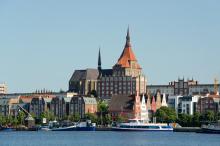Case studies
A regional capital, port city, and strong economic centre on the Mediterranean coast:
Barcelona is a vibrant economic and cultural centre in Europe committed to becoming the global model of a Smart City as it combats urban development challenges related to climate change and population density.
A transboundary regional capital and metropolis on the Baltic Seas:
Both Copenhagen and Malmô are aiming to further incorporate sustainability into their urban development. The two cities have already built a strong economic relationship with one another in the Øresund Region.
A primate city and coastal megacity in the Bosporus region:
One of the world’s most important religious, political and cultural cities faces new urban development challenges associated with population growth, environmental impact and economic advancement.
A dominant coastal capital and port city on the West Atlantic:
Lisbon is a major European economic centre that faces a series of urban development challenges that may increase in intensity with the effects of climate change.
A small city and regional inland centre in central Europe:
A city known for its beauty, artisans, and architecture, Litoměřice faces new challenges in transitioning to a post-carbon city.
Regionally cooperating inland cities in Northern Italy:
Milan and Turin, both essential economic powerhouses of Italy, are proud of their continued innovative spirit to address local issues along with their magnificent cultural and historical riches. Addressing emerging development challenges is essential to maintaining the health of these strategic cities.
The largest city in Mecklenburg-Vorpommern and regional centre on the Baltic Sea coast:
Rostock brings culture, technology and maritime industry together in Germany's Mecklenburg-Vorpommern as it continues to develop and grow as a city.
A historical inland centre in southeast Europe:
Zagreb, a major economic entity in both Croatia and Eastern Europe, boasts a rich history dating back to Roman times. Today, it faces urban development challenges, particularly mobility, as it continues to develop its modern identity.

![By Tango7174. ("Catalunya Barcelona1 tango"), [CC-BY-SA-3.0-2.5-2.0-1.0]](sites/default/files/styles/medium/public/Catalunya_Barcelona1_tango7174_0.jpg%3Fitok=U0-vxOgg)
![By Jim G. ("Kongens Nytorv, Copenhagen, Denmark"). [CC-BY-2.0]](sites/default/files/styles/medium/public/Kongens_Nytorv,_Copenhagen,_Denmark.jpg%3Fitok=aHWrOVb1)
![By Vyacheslav Argenberg. ("Istanbul"), [CC-BY-SA-3.0-2.5-2.0-1.0]](sites/default/files/styles/medium/public/Istanbul.jpg%3Fitok=2v2NSMLJ)
![By Luca Galuzzi. ("Lisboa Praça don Pedro"). [CC-BY-SA-2.5]](sites/default/files/styles/medium/public/Lisbon_09882_Lisboa_Praça_don_Pedro_2006_Luca_Galuzzi_0.jpg%3Fitok=BiRY8-kq)
![By Karelj. ("Cathedral of St. Stephen with belfry in Litoměřice"). [Public domain]](sites/default/files/styles/medium/public/Litoměřice_Sv_Štěpán.jpg%3Fitok=mvFHnpeA)
![By Hpnx9420. ("Turin Monte Cappuccini") [CC-BY-3.0]](sites/default/files/styles/medium/public/Turin_monte_cappuccini_0.jpg%3Fitok=2iKRtNP1)
